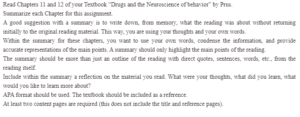Drugs and the Neuroscience of Behavior
Research Summary
The eleventh Chapter of Adam’s Drugs and the Neuroscience of Behavior book discusses cannabinoids as a psychoactive substance. Cannabinoids encompass all drugs that act on the cannabinoid receptors in the body. Cannabinoids are obtained from various parts of the cannabinoid plant. Various phytochemicals are obtained from this plant, all with cannabinoid-like effects (Booth & Bohlmann, 2019). Tetrahydrocannabinol is the most psychoactive substance obtained from these plants. Various forms of cannabis have been utilized for their psychoactive effects. Hashish, e-cigarettes, dabbing, and herbal marijuana are some of these forms. Cannabis product use is restricted in many countries around the globe. These products are classified under Schedule 1 by the Drug Enforcement Administration (DEA) in the US. Dronabinol, a form of cannabinoid, is, however, a Schedule 3 substance.
The inhalational route is the most common route of administration of these substances, although oral routes also exist. The inhalational route provides the fastest onset of action. Due to its slow absorption rates, the onset of action for orally administered cannabinoids is delayed by up to two hours. The duration of action is, however, longer for the oral routes compared to the inhaled route. The bioavailability of cannabinoids is low owing to the high first-pass effect in the liver. The microsomal P450 enzymes use metabolism to produce active metabolites; these substances are highly distributed to fatty tissues and cross the blood-brain barrier.
Cannabinoid compounds produce their effects upon interacting with the endocannabinoid system. Endocannabinoids, in turn, bind to the cannabinoid receptors to elicit their psychoactive effects. These effects include elevation of heart rate, impairment of motor functionality, and increased appetite. Euphoria, overestimation of time passage, and a feeling of relaxation are also present and inform the basis of their use as recreational agents. Repeated use over time leads to pharmacological tolerance. The Chapter concludes by discussing the controversies around the use of cannabinoids. Despite their harmful effects, research points to its benefits in cancer management, substances with the potential to cause weight gain, pain relievers, and agents with the potential to treat immune disorders, among others.
The 12th Chapter discusses psychedelic drugs. The Chapter describes psychedelic drugs as agents that are capable of altering reality experiences. These agents cause delusions, hallucinations, and sensory distortion, among others. Examples of these substances include LSD, MDMA, and phencyclidine, among others. Hallucinogens are a class of psychedelics that cause hallucinations. LSD belongs to this class of agents. Other substances in this category are mescaline, psilocybin, and dimethyltryptamine. LSD is a synthetic being produced in laboratories, while mescaline, dimethyltryptamine, and psilocybin are obtained from plants.
LSD is the most commonly used hallucinogen and is usually administered peroral. It is highly potent and attains peak absorption an hour after ingestion. It is metabolized in the liver with a plasma half-life of about 3 hours (Dolder et al., 2015). The hallucinogenic effects of LSD are attributable to its agonistic activity on the serotonin receptors.
MDMA is an example of a mixed stimulant psychedelic drug. This class of drugs produces both hallucination and stimulation and has effects similar to both hallucinogens and psychostimulants. MDMA is synthetic, often produced in clandestine laboratories, and has been utilized in street parties and raves. It is administered orally, absorbed through the GI tract, and metabolized by the microsomal CYP2D6 and CYP1A2. It acts on the serotonergic pathways to cause the release of serotonin with resultant elevation of sensory stimulation and psychostimulation.
Phencyclidine and ketamine are examples of dissociative anesthetics. These substances produce the feeling of disconnection from the body and have both stimulant and depressant effects. They have also been utilized as pain relievers. Phencyclidine and ketamine have been used in clubs and street parties. They are synthesized in clandestine laboratories and are Schedule 2 classified drugs. Administration of phencyclidine can either be inhalational, intravenous or by insufflation. This drug has a quick onset of action and a considerably longer half-life. This drug produces its effects by interacting with serotonergic, dopaminergic, and cholinergic pathways. The Chapter concludes by discussing other psychedelic drugs, such as dextromethorphan, scopolamine, and salvinorin.
References
Booth, J., & Bohlmann, J. (2019). Terpenes in Cannabis sativa – From plant genome to humans. Plant Science, 284, 67-72. https://doi.org/10.1016/j.plantsci.2019.03.022
Dolder, P., Schmid, Y., Haschke, M., Rentsch, K., & Liechti, M. (2015). Pharmacokinetics and Concentration-Effect Relationship of Oral LSD in Humans. International Journal Of Neuropsychopharmacology, 19(1), pyv072. https://doi.org/10.1093/ijnp/pyv072
Prus, A. An introduction to drugs and the neuroscience of behaviour.
ORDER A PLAGIARISM-FREE PAPER HERE
We’ll write everything from scratch
Question

Drugs and the Neuroscience of Behavior
Read Chapters 11 and 12 of your Textbook “Drugs and the Neuroscience of behavior” by Prus.
Summarize each Chapter for this assignment.
A good suggestion with a summary is to write down, from memory, what the reading was about without returning initially to the original reading material. This way, you are using your thoughts and your own words.
Within the summary for these chapters, you want to use your own words, condense the information, and provide accurate representations of the main points. A summary should only highlight the main points of the reading.
The summary should be more than just an outline of the reading with direct quotes, sentences, words, etc., from the reading itself.
Include within the summary a reflection on the material you read. What were your thoughts, what did you learn, what would you like to learn more about?
APA format should be used. The textbook should be included as a reference.
At least two content pages are required (this does not include the title and reference pages).

